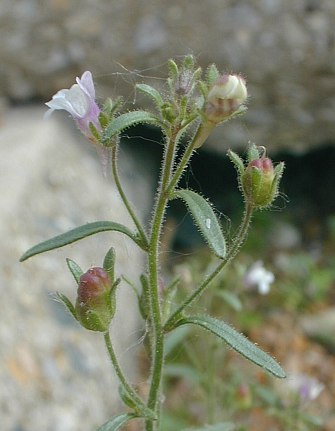Description: This plant is a spring or summer annual that becomes 3-10" tall, branching occasionally. The narrow round stems are covered with white hairs. The lower leaves are opposite, while the middle to upper leaves are alternate. These leaves are up to 1" long and 1/6" (4 mm.) across. They are linear-oblong or linear-oblanceolate, with margins that are ciliate and smooth. From the axil of each middle or upper leaf, a single flower develops from a slender pedicel about 1" long. Sometimes a second flower develops from the leaf axil. Like the stems, these pedicels are covered with white hairs. The flowers are up to 1/4" in length. The corolla is tubular, with 5 spreading lobes in the front and a short spur in the back. The corolla has a small opening at the throat and is more or less two-lipped with 2 upper lobes and 3 lower lobes. It is variously colored, usually some shade of lavender, light purple, or white. Sometimes the corolla is bicolored, with the upper lobes lavender or light purple and the lower lobes white. There are usually a few hairs at the base of the lower lobes. The calyx is green or purplish green and quite hairy. It has 5 oblanceolate lobes that are almost as long as the corolla.

The blooming
period occurs during the summer and it lasts about a month for a colony
of plants. There is no
noticeable floral scent. Each flower is replaced by an ovoid capsule
that contains numerous brown seeds. These seeds are tiny enough to be
dispersed by gusts of wind. The root system consists of a slender
taproot. This plant spreads by reseeding itself.
Cultivation:
This little plant prefers dry sunny conditions and a sterile soil that
is sandy or gravelly. It also grows in partial sun and less dry
conditions, in which case it will become somewhat taller and more
leafy. In fertile soil, this plant is not competitive with taller
vegetation. Alkaline soil is readily tolerated.

Range &
Habitat:
The non-native Dwarf Snapdragon has been reported from most counties in
Illinois (see Distribution
Map). It is occasional to locally common. Habitats include
gravelly areas along railroads (including the ballast), sandy or
gravelly areas along roads, gravelly borders along buildings, and
sterile waste areas. Disturbed areas are preferred. Dwarf Snapdragon is
especially common along railroads in part because the wind gusts
produced by passing trains help to disperse the tiny seeds. This plant
is adventive from the Mediterranean area of Europe. It is less common
along railroad tracks than formerly because of the application of
herbicides.
Faunal Association:
Little information is available about floral-faunal relationships. The
flowers are pollinated by small bees, although they are also capable of
self-pollination. The seeds are too small to be of any interest to
birds, and the insubstantial foliage is unlikely to provide much
nourishment to mammalian herbivores. Humans assist in the dispersal of
the seeds of this plant because of their passing trains and motor
vehicles, as noted above.

Photographic
Location:
A border along a building that was filled with pebbles. This building
was located along a railroad in Urbana, Illinois.
Comments:
Sometimes this plant is called "Small Snapdragon" and "Lesser
Toadflax." It resembles the Linaria spp.
(Toadflaxes) somewhat, except the throat of its corolla is less
obstructed by fuzzy hairs and a palate covers the lower lip. Dwarf
Snapdragon is one of the members of a group of plants that colonize
disturbed sterile soil; these species are ecologically significant
because they help to stabilize and restore the fertility of the soil.
An alternative spelling of the scientific name for this plant is Chaenorrhinum minus.